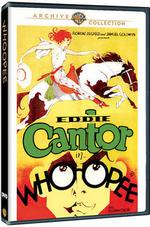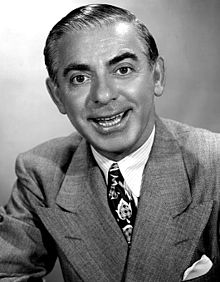Makin’ Whoopee With Eddie Cantor
Posted on May 6, 2013
Filed Under Culture, Films, Main, Music, People, Politics, Radio, Television, TV | Leave a Comment
He’s not a household name today (though his character appears in episodes of “Boardwalk Empire”), but Eddie Cantor was the original renaissance man of the entertainment world in the early 20th century, conquering vaudeville, Broadway, records, Hollywood, radio and TV.
Cantor began in vaudeville in 1907 in New York, moved to the Great White Way in the Ziegfeld Follies in 1917, then starred in such Broadway musical comedies as “Kid Boots” (1923) and “Whoopee!” (1928), as well as recording such hit records as “Makin’ Whoopee,” “If You Knew Susie,” “Ma! He’s Makin’ Eyes at Me,” “Margie” and “How Ya Gonna Keep ‘Em Down on the Farm (After They’ve Seen Paree?).” When Hollywood called, he ported over “Kid Boots” (1926) and “Whoopee!” (1930) and starred in “Roman Scandals” (1933) and “Kid Millions” (1934). He went on to have his own radio show in the 1930s and 1940s and had his own TV show in the 1950s. He was one of the participants in a 1919 strike that founded Actors Equity, helped develop The March of Dimes, and stood up against anti-semitism, censorship and segregation. (According to the Wikipedia entry on Cantor, when he was one of the alternating hosts of the television show ‘The Colgate Comedy Hour,’ the show landed Cantor in an unlikely controversy when a young Sammy Davis, Jr. appeared as a guest performer. Cantor embraced Davis and mopped Davis’s brow with his handkerchief after his performance. When worried sponsors led NBC to threaten cancellation of the show; Cantor’s response was to book Davis for two more weeks.”)
 Warner Home Video has just released two of Cantor’s early films (via “manufacture on demand”) from the Samuel Goldwyn library, each a perfect example of Cantor’s singing, dancing and acting “shtick.” “Whoopee” (1930) is a two-strip Technicolor musical comedy adapted from Cantor’s smash Broadway show in which he plays a neuroses-laden hypochondriac on vacation in the West who becomes involved with a runaway bride and her warring suitors. The dance numbers are choreographed by a Hollywood newcomer — Busby Berkeley — and the bits include a modicum of risque words and actions (for its time). Be warned: there’s some nasty stereotyping in the film, particularly in the portrayal of Native Americans and blacks (Cantor dons blackface — an entertainment staple at the time that few thought anything about — for a lengthy number). Unfortunately, “Whoopee” didn’t play as well as the distributors had hoped for — some of Cantor’s bits were too Jewish or too risque for middle America — and, in an effort to broaden distribution in the hinterlands, Goldwyn toned down Cantor for “Kid Millions” (1934). Here Cantor depicts a simple Brooklyn boy who finds himself on a collision course with charlatans, connivers, sheiks, and she-devils on the way to inheriting a fortune in Egypt. The film is notable for appearances by Ann Sothern, Ethel Merman, George Murphy, Paul Harvey and Edgar Kennedy –with a surprisingly weird three-strip Technicolor finish. (By the way, this “toning down” became Hollywood’s model for reaching the masses in America).
Warner Home Video has just released two of Cantor’s early films (via “manufacture on demand”) from the Samuel Goldwyn library, each a perfect example of Cantor’s singing, dancing and acting “shtick.” “Whoopee” (1930) is a two-strip Technicolor musical comedy adapted from Cantor’s smash Broadway show in which he plays a neuroses-laden hypochondriac on vacation in the West who becomes involved with a runaway bride and her warring suitors. The dance numbers are choreographed by a Hollywood newcomer — Busby Berkeley — and the bits include a modicum of risque words and actions (for its time). Be warned: there’s some nasty stereotyping in the film, particularly in the portrayal of Native Americans and blacks (Cantor dons blackface — an entertainment staple at the time that few thought anything about — for a lengthy number). Unfortunately, “Whoopee” didn’t play as well as the distributors had hoped for — some of Cantor’s bits were too Jewish or too risque for middle America — and, in an effort to broaden distribution in the hinterlands, Goldwyn toned down Cantor for “Kid Millions” (1934). Here Cantor depicts a simple Brooklyn boy who finds himself on a collision course with charlatans, connivers, sheiks, and she-devils on the way to inheriting a fortune in Egypt. The film is notable for appearances by Ann Sothern, Ethel Merman, George Murphy, Paul Harvey and Edgar Kennedy –with a surprisingly weird three-strip Technicolor finish. (By the way, this “toning down” became Hollywood’s model for reaching the masses in America).
Both films can be ordered by pointing your browser to WBShop.com.
Comments
Leave a Reply
